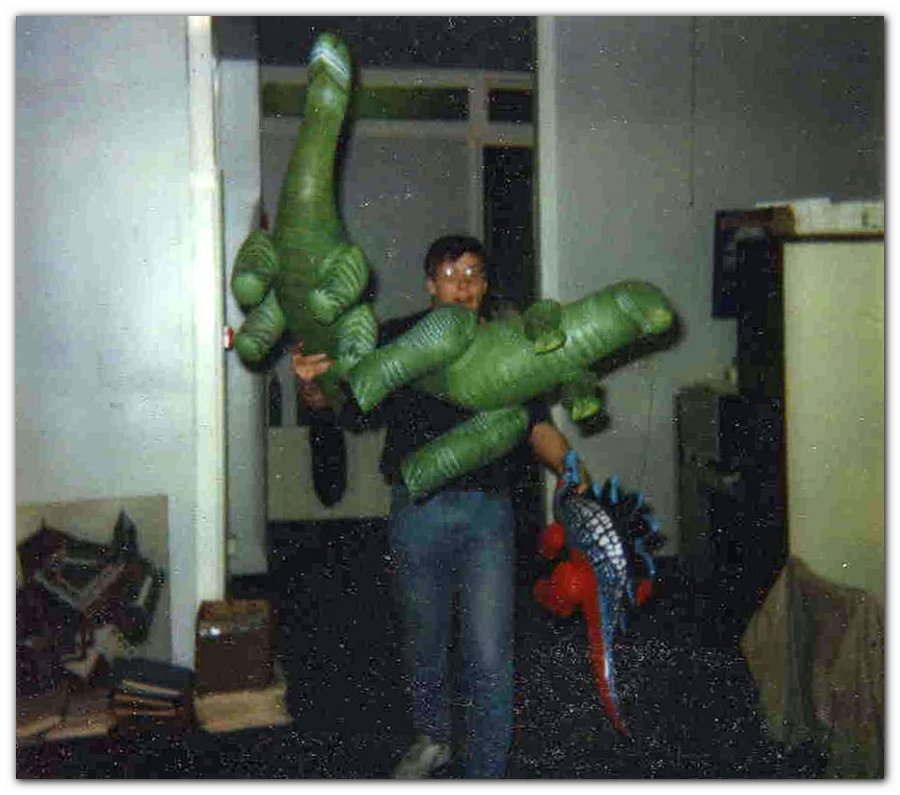Is that him, in the picture? No no, surely this is just your friendly, local neighbourhood inflatable dinosaur juggler!
No, fred23 was a program not a person. To understand what fred23 was, it's is necessary to explain a bit about the Magnetic Scrolls' world model.
The World Model
Rooms, objects and people within a Magnetic Scrolls adventure game had a standard set of properties that described, in considerable detail, their behaviour including their descriptions and how they might be manipulated.
For example, doors knew if they were open or closed and where they would lead to. Items knew if they could be picked up and carried. You could sit on chairs. Put things on tables, or into containers. Items knew how big they were, how heavy they were and all sort of interesting properties. The exact hows and whats merit a separate blog article.
The world model was supported by the base game system that was present in all adventures. It meant you could have a working game, in which you could walk about, move things, open doors and do a wide variety of operations, without even a single line of game specific code - because it was all part of the base system.
And this is where fred23 came in; fred23 was the build tool that compiled these properties into the binary format used by the internals of the game.
When making a new game, the first thing to do would be for the game designer or writer to do the "fredding". He or she would use the fred23 tool to build a "dry" game. This game could then be run (without coding) and the designer could explore the game to get a feel for the layout, check the descriptions and try doing things with objects to see what things felt like.
There were about 50 properties altogether and some of those had various value states. So, together with hundreds of game objects, this represented a formidable challenge of testing and checking - not to mention tedious. Which, of course, is how fred23 became to be so feared. It was easily the most tedious part of the game production from the designer's point of view.
Why Fred 23?
I don't know for sure, but my theory is that, really, it's actually fred 2.3. Back then file names could only have one dot "." in them, and that was usually the name suffix, eg fred23.exe.
I remember there being a version 1 fred, but this was only a prototype, not used for production.
Fred23jr
There was a new kid on the block; fred23 junior aka fred23jr.
This was a much improved "fred" tool that was used for the later games. In fact, it was so good that it's likely that the earlier ones were later "unfredded" into this format. fred23jr represents the third generation "fredder".
From writers; it was like LOL OMFG this is so rad by comparison (I exaggerate slightly).
We have managed to recover the source code for fred23jr and will be publishing it in due course, along with some of the input documents that describe the game properties in detail.
Who?
So who then is the person in the picture? Wait a minute! That's Rob Steggles, from June 1988. He must be taking a well earned break from the torment of fred23. Probably driven half crazy (which would explain the dinosaur juggling).
Even experienced writers would rather chew their own arms off than face the agony of fred23 - that or go crazy.
Rob claims, he's seen here "attempting to juggle some inflatable dinosaurs whilst waiting for Corruption to compile", but I don't believe a word of it. Clearly, he's lost his mind. Just look at those wild staring eyes! It's obvious.
By a cruel twist of fake, it seems that his fred23 days might not be over, as it might be possible to remaster the original games from their original source code - with added extra features.
So Rob; how scared are you now!
Notes
Apologies for the poor quality of this photo. But it's one of the few surviving images taken at the Magnetic Scrolls offices, 1 Chapel Court London.
Note the Escher print bottom left and the DEC MicroVAX behind Rob on the right, and you can just make out a poster of The Guild above it (if you look carefully).
